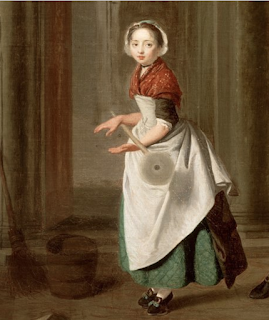Susan reporting,
I wrote earlier this week here about the wavy-ring 18thc pattens - a kind of overshoe with a wooden sole and a metal ring intended to raise the wearer's shoes above wet or otherwise unpleasant terrain - that were being recreated and worn as part of the Historic Trades program at Colonial Williamsburg.
In the course of my discussion about the pattens with apprentice tinsmith Jenny Linn and journeywoman blacksmith Aislinn Lewis (both of whom were involved in the creation, wearing, and research of the replica pattens), we also spoke of a slightly different kind of 18thc pattens. Although the wooden sole and leather straps and laces are much the same, these pattens feature a round metal ring as a support. While the wavy-ring pattens offer plenty of surface area and almost resemble the treads of modern winter boots, the narrower base of the round-ring style would be much more precarious for both balance and walking.
This, however, may be because they weren't intended for walking. Jenny and Aislinn suggested that this type of pattens served an entirely different purpose. In 18thc prints, the round-ring style is usually shown worn by housemaids indoors, and often with a a bucket and mop nearby.
Examples include Piety in pattens, or, Timbertoe on tiptoe, upper left, with a tall maidservant made even taller by very high round-ring pattens. In How are you off for soap, middle right, the ring-bottom pattens are worn by a laundress, whose work would also include splashing soapy water.
The maid of all work in Roberteena Peelena, lower right, not only wears the round-ring style, but has pinned her petticoat up to avoid the wash-water. The maid in the painting A City Shower, lower left, has stepped outside with her bucket, and vigorously twirls her wet mop while poised (rather daintily) on her round-ring pattens. (A side-note: apparently rolling the mop's handle across the forearms instead of with the wrists looks like it was the accepted method of mop-twirling.)
When the round-ring style appears in prints being worn outdoors in the streets, they seem to be a way that the caricaturist is indicating that the wearer is of a lower or serving class, and a woman who is (in the cruel manner of 18thc caricatures) humorously lower class, unstylish, or down on her luck (here and here.)
From these sources, it appears that the the round-ring style was worn primarily indoors rather than out, to raise the wearer above soapy water spilled on a wet floor. They may also have served to protect a clean, wet floor from dirty shoes, rather than protecting the shoes from the water. Unfortunately there doesn't seem to be any primary source documentation in the form of letters or journals to explain this further. If anyone has come across such research, I hope you'll share it.
Many thanks to Jenny Lynn and Aislinn Lewis for their assistance with this post.
Upper left: Pattens, leather, wood, & iron rings, c1780-1800, Victoria & Albert Museum.
Upper right: Piety in pattens, or Timbertoe on tiptoe, published by M. Darly, 1773. Walpole Library, Yale University.
Middle left: Detail, How are you off for soap, published by William Elmes, 1816. Walpole Library, Yale University.
Lower right: Roberteena Peelena, the maid of all work by William Heath, 1829, British Museum.
Lower left: Detail, A City Shower by Edward Penny, 1764, Museum of London.
Thursday, October 18, 2018
So Who Wore Round-Ring Pattens in the 18th Century?
Thursday, October 18, 2018
Posted by
Susan Holloway Scott
at
12:00 AM
Labels: 18th century, Colonial Williamsburg, fashion history, historic dress, historic trades, interesting objects, shoes, Susan Holloway Scott
Comments:
Labels: 18th century, Colonial Williamsburg, fashion history, historic dress, historic trades, interesting objects, shoes, Susan Holloway Scott
Comments:
Subscribe to:
Post Comments (Atom)





 One of us --
One of us -- 



1 comments:
So interesting, especially the illustrations that you have found. It is always more difficult finding images of the 'lower orders'.
There is a later example of a literary character wearing pattens, occurring in The Cricket on the Hearth, by Charles Dickens. I don't have my copy with me, so I can't quote, but Dickens comments on Dot's pattens making geometric patterns in the snow outside the door of their home. I assumed that they were round rings which would fit with your premise that round pattens were for outdoor wear by lower class women.
One of my Scottish ancestors was noted for wearing pattens in my great-aunt's family history. Why was that noteworthy I wonder?
Post a Comment